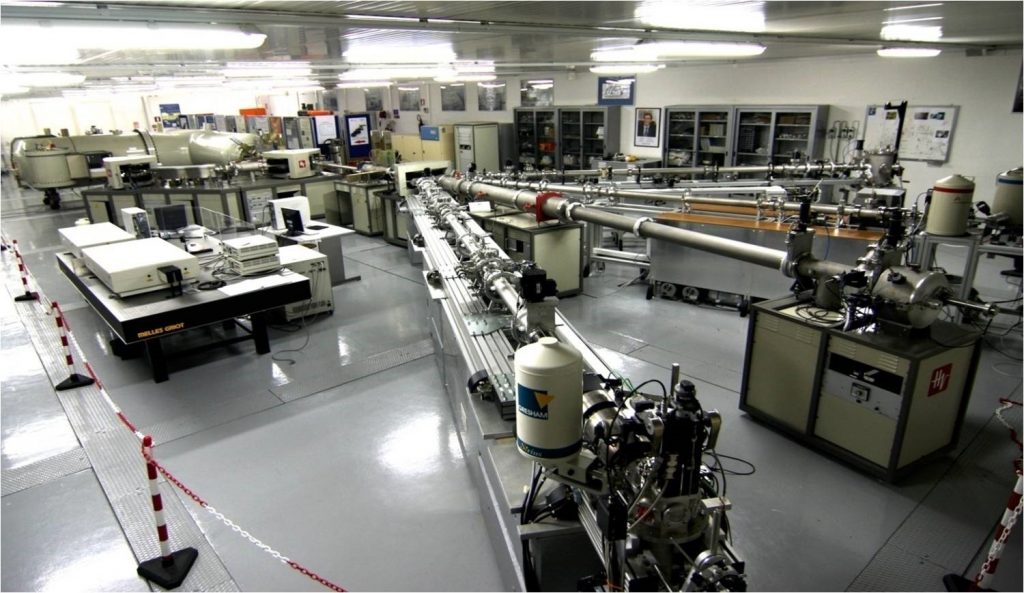Accelerator Mass Spectrometry-Isotope Ration Mass Spectrometry for radiocarbon dating (AMS-IRMS)
UNIVERSITY OF SALENTO

A 3 MV Tandetron accelerator (High Voltage Engineering Europe BV) is available for CERIC-ERIC users. The accelerator is equipped with different beamlines for:
• AMS (Accelerator Mass Spectrometry) dedicated to radiocarbon dating.
There is a multi-cathode sputtering ion source with an automated sample handling system allowing the unattended operation. It is routinely used for radiocarbon dating with precision levels of 0.3% and 0.05% on the measurement of 14C/12C and 13C/12C isotopic ratios. By achieving machine blank levels of 10-16 (14C/12C), it enables the analysis of samples as old as 50 ka.
The AMS facility also includes a hybrid ion sputtering ion source connected to a EA (Elemental Analyzer), a GAS BENCH II and IRMS (Isotope Ration Mass Spectrometry). The ion source accepts both solid and gaseous samples, enabling radiocarbon dating and stable isotope analyses on microgram-range materials. Typical applications include the analysis of precious samples, of airborne particles, of organic residues in archaeological artefacts.
The facility also houses chemical processing laboratories equipped with all the necessary instruments for preparing a wide range of materials submitted to AMS radiocarbon dating. Samples such as bones, charcoal, vegetal remains, textiles, leather, carbonates are routinely prepared. Ancillary facilities are available to assess sample conservation, detect contaminants, and evaluate chemical procedure effectiveness.
• EA – Elemental Analyzer for the simultaneous on-line determination of C and N as well as a second dedicated high temperature reactor for the simultaneous on-line determination of H and O, including an autosampler with 32 positions and the Eager software for IRMS computer and TCD detector.
• GASBENCH II Automated sample preparation device for determination of isotope ratios of gases such as CO2 from air or CO2 released from carbonates, CO2 from dissolved inorganic carbon (DIC), 18O and D analysis of samples aqueous by CO2/H2O, H2/H2O equilibration.
The gases, entrained in a carrier gas stream, are sent to a GC column via an automated sampling loop. The water is removed by a non-cryogenic phase separator. Coupling to the mass spectrometer is via a built-in open split and reference gas injection system with 3 reference gases.
• DELTA V PLUS Isotope Ratio Mass Spectrometer for high precision measurement of the relative isotope abundances of 13C, 15N, 18O, 34S and 2H (D) consisting of:
Ion Source at 3 kV acceleration voltage;
Mass Range from 1 to 96 u and Resolution better than 110;
Universal triple collector is suitable for all standard applications involving N2 and CO (28, 29, 30), NO (30, 31,32), O2 (32, 33, 34), CO2 and N2O (44, 45, 46), and SO2 (64, 66).
Isodat Software Suite including its peripherals, controlling and automating the complete analysis from sample preparation to data reporting.
Moreover the 3MV HVEE Tandetron Accelerator is able to perform:
• In vacuum and in air irradiation with MeV particles (from protons to actinides). The beamline features electrostatic beam scanning units, multiple sample holder and beam dose control.
• RBS (Rutherford Backscattering Spectrometry). The beamline incorporates a scattering chamber allowing the x-y positioning of the investigated samples and a high resolution goniometer for channeling experiments.
• PIXE (Particle Induced X-Ray Spectrometry), PIGE (Particle Induced Gamma Ray Spectrometry), IBIL (Ion Beam Induced Luminescence) set-up. This beamlines allows the analysis of samples in external beam mode at atmospheric pressure. The experimental apparatus is particularly suitable for sample highly sensitive to radiation damage and with complex geometries.
• Nuclear microprobe with MeV protons delivered in vacuum and in air with a spatial resolution of the order of one micrometer.
Contact:
Lucio Calcagnile – Director (tel:+39 0832 29 5050 | +39 0832 29 5051)
Gianluca Quarta (tel:+39 0832 29 5050 | +39 0832 29 5054)
Marisa D’Elia (tel:+39 0832 29 5050 | +39 0832 29 5052)
Lucio Maruccio (tel:+39 0832 29 5050 | +39 0832 29 5055)
-
20.07.2023
Hydrogen Technology Center (HTC)



